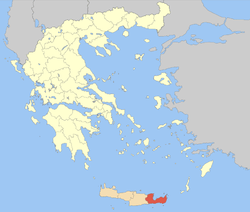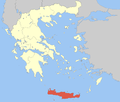Lasithi
| Lasithi Περιφερειακή ενότητα Λασιθίου | |
|---|---|
| Regional unit | |
|
Municipalities of Lasithi | |
 Lasithi within Greece | |
| Coordinates: 35°05′N 25°50′E / 35.083°N 25.833°ECoordinates: 35°05′N 25°50′E / 35.083°N 25.833°E | |
| Country | Greece |
| Region | Crete |
| Capital | Agios Nikolaos |
| Area | |
| • Total | 1,823 km2 (704 sq mi) |
| Population (2011) | |
| • Total | 75,381 |
| • Density | 41/km2 (110/sq mi) |
| Postal codes | 72x xx |
| Area codes | 284x0 |
| ISO 3166 code | GR-92 |
| Car plates | ΑΝ |
| Website |
www |
Lasithi (Greek: Λασίθι) is the easternmost regional unit on the island of Crete, to the east of Heraklion. Its capital is Agios Nikolaos, the other major towns being Ierapetra, Sitia and Neapoli. The mountains include the Dikti in the west and the Thrypti in the east. The Sea of Crete lies to the north and the Libyan Sea to the south.
To the east of the village of Elounda lies the island of Spinalonga, formerly a Venetian fortress and a leper colony. On the foot of Mount Dikti lies the Lasithi Plateau, famous for its windmills. Vai is well known for its datepalm forest.
Thanks to stunning beaches and its mild climate year-long, Lasithi attracts many tourists. Mass tourism is served by places like Vai, Agios Nikolaos and the island of Chrissi. More off-beat tourism can be found in villages on the south coast like Myrtos, Makrys Gialos or Makrigialos, Xerokambos and Koutsouras.
Lasithi is home to a number of ancient remains. Vasiliki, Fournou Korifi, Pyrgos, Zakros and Gournia are ruins of Minoan date, Lato and Itanos were Doric towns.
History
The history of Lasithi can be traced over at least three millennia.[1] The region has considerable ancient history antecedents, including the Dorian era settlement of Olous and Lato.[2]
Administration
The regional unit Lasithi is subdivided into four municipalities. These are (number as in the map in the infobox):[3]
- Agios Nikolaos (1)
- Ierapetra (2)
- Oropedio Lasithiou (3)
- Siteia (4)
Prefecture
As a part of the 2011 Kallikratis government reform, the regional unit Lasithi was created out of the former prefecture of Lasithi (Greek: Νομός Λασιθίου), which was created while Crete was still an autonomous state and was retained after the island joined Greece in 1913. The prefecture had the same territory as the present regional unit, except Viannos area that belonged to Lasithi but was annexed to Heraklion prefecture in 1932. At the same time, the municipalities were reorganised, according to the table below.[3]
| New municipality | Old municipalities | Seat |
|---|---|---|
| Agios Nikolaos | Agios Nikolaos | Agios Nikolaos |
| Vrachasi | ||
| Neapoli | ||
| Ierapetra | Ierapetra | Ierapetra |
| Makry Gialos | ||
| Oropedio Lasithiou | Oropedio Lasithiou | Tzermiado |
| Siteia | Siteia | Siteia |
| Itanos | ||
| Lefki |
Provinces
Before 2006, Lasithi was divided into 4 provinces:
- Province of Mirambelos - Neapolis
- Province of Lasithi - Tzermiado
- Province of Ierapetra - Ierapetra
- Province of Sitia - Sitia
Transport
See also
References
- ↑ Livingston Vance Watrous, Lasithi, a History of Settlement on a Highland Plain in Crete, 1982, 89 pages
- ↑ C.Michael Hogan, Lato Fieldnotes, The Modern Antiquarian, Jan 10, 2008
- 1 2 "Kallikratis reform law text" (PDF).

